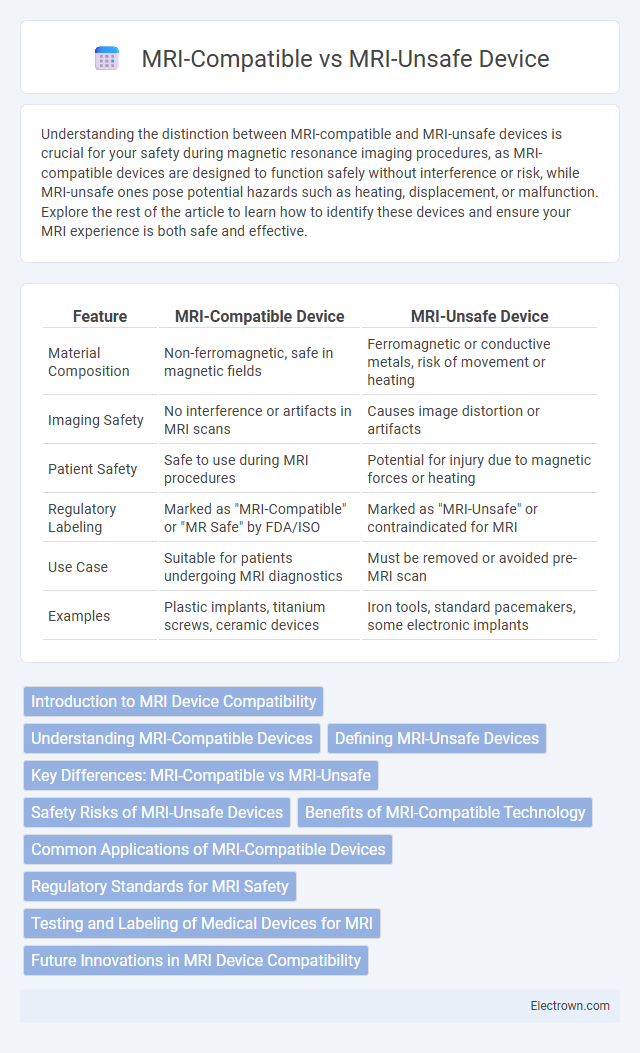Understanding the distinction between MRI-compatible and MRI-unsafe devices is crucial for your safety during magnetic resonance imaging procedures, as MRI-compatible devices are designed to function safely without interference or risk, while MRI-unsafe ones pose potential hazards such as heating, displacement, or malfunction. Explore the rest of the article to learn how to identify these devices and ensure your MRI experience is both safe and effective.
Table of Comparison
| Feature | MRI-Compatible Device | MRI-Unsafe Device |
|---|---|---|
| Material Composition | Non-ferromagnetic, safe in magnetic fields | Ferromagnetic or conductive metals, risk of movement or heating |
| Imaging Safety | No interference or artifacts in MRI scans | Causes image distortion or artifacts |
| Patient Safety | Safe to use during MRI procedures | Potential for injury due to magnetic forces or heating |
| Regulatory Labeling | Marked as "MRI-Compatible" or "MR Safe" by FDA/ISO | Marked as "MRI-Unsafe" or contraindicated for MRI |
| Use Case | Suitable for patients undergoing MRI diagnostics | Must be removed or avoided pre-MRI scan |
| Examples | Plastic implants, titanium screws, ceramic devices | Iron tools, standard pacemakers, some electronic implants |
Introduction to MRI Device Compatibility
MRI-compatible devices are specifically designed with non-magnetic materials to function safely within the magnetic resonance imaging environment, minimizing risks such as heating, movement, or image distortion. MRI-unsafe devices contain ferromagnetic components that can cause serious hazards, including device malfunction, patient injury, or compromised imaging quality. Understanding the compatibility classification is crucial for ensuring patient safety and accurate diagnostic outcomes during MRI procedures.
Understanding MRI-Compatible Devices
MRI-compatible devices are specifically designed and tested to function safely within the strong magnetic fields and radiofrequency pulses of an MRI scanner, minimizing risks of injury or device malfunction. Understanding your device's MRI-compatibility involves reviewing manufacturer guidelines and regulatory certifications to ensure it does not contain ferromagnetic materials or electronic components susceptible to interference. Proper identification of MRI-safe devices enables safe imaging without compromising diagnostic accuracy or patient safety during the MRI procedure.
Defining MRI-Unsafe Devices
MRI-unsafe devices are medical implants or equipment that pose risks during MRI scans due to their ferromagnetic properties, which can cause movement, heating, or malfunction inside the MRI's strong magnetic field. These devices may distort imaging results and endanger your safety by causing burns, mechanical injury, or device failure. Understanding which devices are MRI-unsafe is crucial for ensuring accurate diagnostics and preventing complications during your MRI procedure.
Key Differences: MRI-Compatible vs MRI-Unsafe
MRI-compatible devices are specifically designed with non-ferromagnetic materials that prevent interference with magnetic fields, ensuring safety and clear imaging during MRI scans. In contrast, MRI-unsafe devices contain ferromagnetic components that can pose serious hazards such as device displacement, heating, or image distortion. Understanding these differences protects your safety and ensures accurate diagnostic results during MRI procedures.
Safety Risks of MRI-Unsafe Devices
MRI-unsafe devices pose significant safety risks due to their potential to interfere with the magnetic field, causing device malfunction or movement that can lead to injury. Metallic implants or electronic devices not designed for MRI compatibility may heat up, shift, or cause burns during the scan, endangering your health. Ensuring your medical devices are MRI-compatible is crucial to prevent complications and guarantee a safe imaging experience.
Benefits of MRI-Compatible Technology
MRI-compatible devices significantly enhance patient safety by minimizing the risk of magnetic interference and heating during scans, ensuring accurate imaging results. These devices reduce scan time and the need for repeat procedures, leading to improved diagnostic efficiency and patient comfort. Choosing MRI-compatible technology for Your medical equipment supports seamless integration with advanced imaging protocols and enhances overall clinical workflow.
Common Applications of MRI-Compatible Devices
MRI-compatible devices are essential in medical settings to ensure patient safety and imaging accuracy during magnetic resonance imaging procedures. Common applications include cardiac pacemakers, cochlear implants, and certain types of surgical instruments designed specifically to minimize magnetic interference. Your healthcare provider can guide the selection of these MRI-safe devices to prevent complications and obtain reliable diagnostic results.
Regulatory Standards for MRI Safety
MRI-compatible devices meet stringent regulatory standards such as FDA guidelines and ASTM International's F2503 standard, ensuring safety and functionality in high magnetic fields. MRI-unsafe devices fail to comply with these criteria, posing risks like device malfunction, patient injury, or image artifacts during scans. Ensuring your medical device aligns with recognized MRI safety standards protects patient well-being and diagnostic accuracy.
Testing and Labeling of Medical Devices for MRI
Medical devices undergo rigorous testing to determine MRI compatibility, including assessments of magnetic field interactions, heating, and image artifacts following ASTM International standards such as F2503. Devices are labeled as MRI-Compatible if they demonstrate safety and functionality within MRI environments, while MRI-Unsafe devices pose risks of movement, heating, or malfunction in the magnetic field. Proper labeling ensures healthcare providers can identify safe equipment, minimizing patient hazards during MRI procedures.
Future Innovations in MRI Device Compatibility
Future innovations in MRI device compatibility are focused on enhancing safety and functionality by developing materials and technologies that minimize electromagnetic interference and heating effects. Advances in smart sensors and wireless communication within MRI-compatible devices aim to improve patient monitoring without compromising image quality. Your ability to safely use advanced medical implants during MRI scans will expand as these innovations integrate biocompatible and adaptive features to support diagnostic precision.
MRI-Compatible vs MRI-Unsafe Device Infographic

 electrown.com
electrown.com